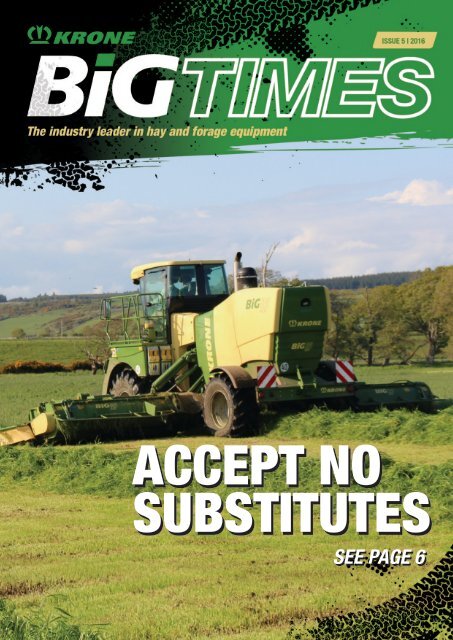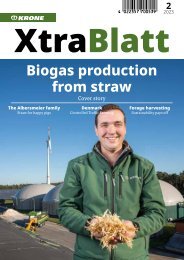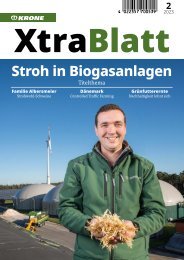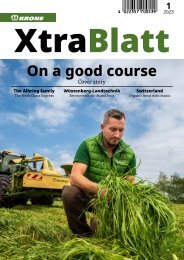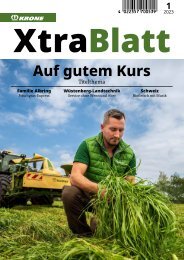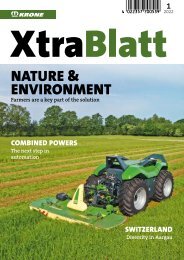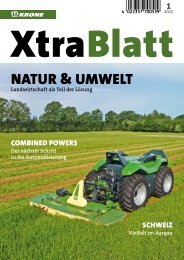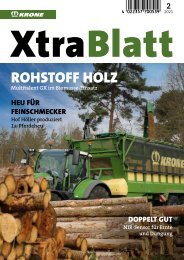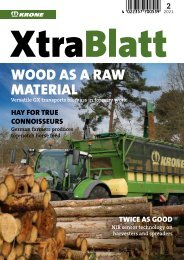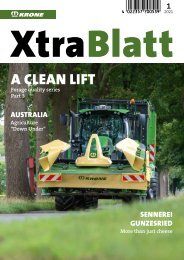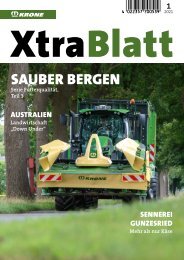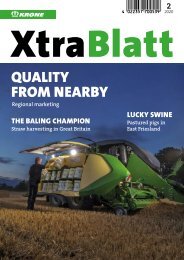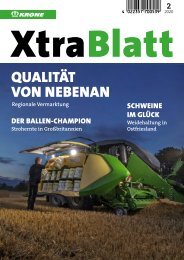BiG Times Issue 5
The KRONE UK magazine Issue 5 including tips, product news, company updates, customer testimonials and more.
The KRONE UK magazine Issue 5 including tips, product news, company updates, customer testimonials and more.
You also want an ePaper? Increase the reach of your titles
YUMPU automatically turns print PDFs into web optimized ePapers that Google loves.
ACCEPT NO<br />
SUBSTITUTES<br />
SEE PAGE 6<br />
SEE PAGE 6
Welcome<br />
Despite 2016 proving itself a challenging year for UK agriculture, our outlook<br />
remains positive. Extreme weather, poor commodity prices and the uncertainty<br />
of our EU membership, are all presenting their own challenges, but as is often the<br />
case, challenges produce opportunities. Now is the time for us all to look at our<br />
businesses to increase efficiencies and explore new markets.<br />
We understand that well maintained, reliable machinery plays a key role in<br />
running an efficient operation and making sure that your forage machinery is in<br />
the best possible condition can make all the difference between an excellent or<br />
poor harvest. Ensuring your machines are well serviced with worn parts replaced<br />
with genuine replacement parts is essential. Inevitably there becomes a point<br />
where maintaining a piece of equipment is no longer economically viable and<br />
you need to look at replacing it. Purchasing a new machine can often seem like<br />
the safe option with full manufacturer’s warranty and attractive finance, often<br />
with 0% interest; however all of this can come at a price… Have you considered<br />
buying a preowned machine? With more and more customers looking for quality<br />
used equipment we have recently launched our Krone Forage Solutions website,<br />
which offers a wide range of used machines, with all our Krone machines<br />
stamped with our seal of approval meaning you can benefit from attractive retail<br />
finance and limited Krone warranty at an affordable price.<br />
On the back page of this edition<br />
you can find out more about Krone<br />
Forage Solutions and how you can<br />
Marcus Oliver<br />
Managing Director<br />
purchase a machine. You can also read how Krone machines have helped some<br />
of our customers enhance their businesses and in particular how one<br />
customer in Northamptonshire has diversified into Bio Energy. Along with<br />
a roundup of Krone news and product updates with a particular focus on<br />
our mowers.<br />
With the season underway and the clamps starting to fill up now is the time to<br />
make sure you’re well stocked with all the Krone genuine wearing parts you’ll<br />
need to keep you running throughout the season.<br />
From all at Krone we wish you a successful harvest.<br />
Marcus Oliver<br />
Managing Director<br />
Krone UK<br />
Krone UK Ltd<br />
Peckfield Business Park<br />
Phoenix Avenue, Micklefield<br />
Leeds LS25 4DY<br />
What’s in this issue<br />
SIMPLE, EFFECTIVE MOWING<br />
P4<br />
BIG JUST GOT BETTER<br />
P5<br />
ACCEPT NO SUBSTITUTES P6-9<br />
OPERATOR FRIENDLY KRONE BALER TAKES<br />
PRESSURE OFF WORKLOAD<br />
STRONG VERSATILE BALERS NEEDED FOR<br />
ABERDEEN CONTRACTORS<br />
P13<br />
P14<br />
Tel No: 0113 287 8800<br />
Fax No: 0113 287 8811<br />
Parts Tel No: 0113 287 8808<br />
Parts Fax No: 0113 287 8812<br />
Internet: www.krone-uk.com<br />
https://www.facebook.com/KroneUKLtd<br />
WIDE SPREAD PRODUCES FASTER WILT<br />
INCREASING DAIRY HERD SIZE REQUIRES<br />
FORAGE PRODUCTION UPGRADE<br />
P10<br />
P11<br />
NEW BIG X OFFERS EVEN BETTER CHOP AND<br />
MORE OUTPUT<br />
WHO ARE FORAGE SOLUTIONS?<br />
P15<br />
P16<br />
@KroneUK<br />
@KroneUK<br />
FORAGE WAGON FEEDS TO ORDER<br />
P12<br />
Krone UK Ltd<br />
3
Company NEWS<br />
CALLING ALL<br />
KRONE FANS…<br />
Krone UK has recently launched their online<br />
shop allowing fans to order Krone<br />
merchandise online. If you’re looking for a<br />
present for the person who’s got everything or<br />
you fancy treating yourself, then why not visit<br />
www.krone-uk.com and click shop.<br />
SIMPLE, EFFECTIVE MOWING<br />
Krone have updated their mower line<br />
up with the addition of the<br />
ActiveMow. Its’ simple robust design<br />
provides a side pivoting mower bed and<br />
spring suspensions that makes it ideal<br />
for small to medium farmers.<br />
The range consists of five models with working widths from 2.0m to 3.6m which superceeds<br />
the familiar AM range. All ActiveMow have inherited the familiar features of SafeCut disc<br />
protection system and SmartCut mower bed with optimised disc overlap for difficult conditions<br />
from the EasyCut range, whilst retaining the familiar features associated with the AM, such as<br />
quick change blades, easy attachment and simple robust design.<br />
Understanding that safe transport and storage space can be an issue, all ActiveMow mowers<br />
now fold vertically past 90 degrees to give greater visibility from the cab and better weight<br />
distribution. They also have the possibility to be stored securely in the upright transport<br />
position, saving valuable shed space.<br />
4<br />
Dates for your Diary<br />
SCOTGRASS: 18TH MAY - CRICHTON COLLEGE, DUMFRIES<br />
ROYAL WELSH GRASSLAND: 9TH JUNE - RHUG ESTATE, CORWEN<br />
CEREALS: 15TH & 16TH JUNE – CHRISHALL GRANGE, DUXFORD, CAMBS<br />
ROYAL HIGHLAND SHOW: 23RD TO 26TH JUNE – ROYAL HIGHLAND<br />
CENTRE, INGLESTON, EDINBURGH<br />
ROYAL WELSH SHOW: 18TH TO 21ST JULY – ROYAL<br />
WELSH SHOW GROUND, BUILTH WELLS, POWYS<br />
THE DAIRY SHOW: 5TH OCTOBER - ROYAL BATH & WEST<br />
SHOWGROUND, SHEPTON MALLET<br />
Follow Us<br />
Keep up to date by following us on Facebook, Twitter,<br />
LinkedIn, Instagram & YouTube.
Krone UK have extended their range of forage harvesters with the introduction of 3 new models at their ‘<strong>BiG</strong> Just<br />
Got Better’ working demonstration last autumn near Whitchurch in Shropshire. The event saw the launch of its<br />
new <strong>BiG</strong> X 530, 630 and 770 models, which completes the circle and brings the total to nine in the range. The new<br />
additions will be available for the first time this spring as full production machines and are designed for both<br />
growers and contractors.<br />
New design features aim to maximise performance and durability while<br />
remaining simple to operate and service and of course ensuring operator comfort<br />
is achieved as a priority. The three new models offer growers and contractors a<br />
wider choice, with the larger 630 and 770 machines giving contractors improved<br />
versatility when harvesting a wider variety of crops.<br />
Six feed rollers ensure uniform performance and that optimum crop flow is<br />
achieved even in inconsistent swaths, and is aided by VariStream to help level out<br />
peaks and troughs, ultimately improving efficiency. The current chopping cylinder<br />
has been replaced on all models with the MaxFlow drum to produce<br />
twice the crop carrying capacity , therefore significantly<br />
increasing the productivity of the forager. The <strong>BiG</strong> X 480<br />
to 630 models feature a 630mm wide drum and for the<br />
<strong>BiG</strong> X 600 – 1100 an 800mm wide drum, , all with a<br />
660mm diameter and the option of 20, 28 or 36<br />
knives offering chop length variation from 3-31mm.<br />
Chop length can be doubled on each knife specification<br />
by removing half the knives.<br />
On the <strong>BiG</strong> X 480 to 630 is the new VariQuick feature that<br />
allows a fast and simple change over between corn conditioner<br />
and grass chute and is particularly relevant for contractors potentially<br />
working between grass and whole crop on a daily basis. Standard on the <strong>BiG</strong> X<br />
480-630 models is the new independent Wishbone Suspension fitted on the rear<br />
axle of 4WD and 2WD options. Designed to provide maximum operator comfort<br />
over the roughest of terrain, this feature also allows the engine to be seated<br />
lower, increasing driver visibility. A 50 degree steering angle can also be achieved<br />
which is ideal on headlands and when in tight situations.<br />
Produce twice the crop carrying capacity<br />
with the MaxFlow drum<br />
With operator comfort again a key focus, climate control in the cab is now<br />
standard and a deeper and wider cab makes more space, while a wide<br />
windscreen and high side windows optimises visibility especially of the spout. An<br />
ergonomic gearstick gives optimum operator comfort and easy to reach buttons<br />
and touch screen terminal helps reduce fatigue.<br />
Power for the <strong>BiG</strong> X 530 and 630 come from MTU 6R 1300 530hp and MTU 6R<br />
1500 626hp engines respectively, and for the 770 it is a MAN D2868 V8<br />
729hp engine.<br />
The larger range of foragers have all received a facelift and have<br />
been joined by the <strong>BiG</strong> X 770, which now fills the gap<br />
between the <strong>BiG</strong> X 700 and 850, giving an extra option to<br />
those wanting more from a 700. Some new features<br />
include a drum brake that can stop the machine in<br />
less than 10 seconds and is fitted as standard. A 300l<br />
additive tank including pump terminal control can be<br />
used for additive dosing. The company’s on board<br />
computer software ICAN is available with yield and<br />
moisture metering and features a printer, it can be linked to<br />
a mobile app for task and date recording.<br />
Also new to the larger range, including the 770, is a spout extension for 10, 12<br />
and 14 row machines with a square end for grass and conical shape end for<br />
maize. A new modern and stylish design also includes features such as a new<br />
larger in cab monitor for easier operation, LED lighting, mirror guards and<br />
mud guards.<br />
5
Product FOCUS<br />
An EasyCut F 320 CV front mower with EasyCut<br />
B 1000CV Collect mowers making light work of a<br />
field with their 10.1m cutting width<br />
The industry leader in hay and forage equipment<br />
6<br />
ACCEPT NO SUBSTITUTES<br />
Krone has a long established pedigree in the design and<br />
manufacture of mowers and mower beds. Briefly, it<br />
started in the early 1980’s when drum mower production<br />
was ceased and was succeeded by the manufacture of the<br />
AM disc mower range. This change was driven by a demand<br />
for higher capacity mowing.<br />
The mower and the bed were designed by the Krone engineer Wilhelm Ahler, which is<br />
a design that has stood the test of time playing a key role in the success of Krone<br />
mowers. Although the design has been refined over the last 30 years there have been<br />
no radical changes, compare a mower from now and then and you can recognise a lot<br />
of the same features. Such as a fully welded mower bed for extra strength and<br />
durability and the use of planetary main drive and satellite disc drive gears, now called<br />
SmartCut. Designed to run at a slower rpm, this drive system significantly reduced<br />
wear and power consumption, whilst the forward mounting of the cutting disc provided<br />
a smoother, gentler action with a flatter blade projection, producing even stubble heights.<br />
The AM disc mower with a fully welded bed and powered from<br />
below by a satellite gear system<br />
Today these initial features can be found across the full range of Krone mowers from the rear mounted ActiveMow, front, rear, trailed and butterfly EasyCut and<br />
the awesome self propelled <strong>BiG</strong> M. They have also been joined by other features such SafeCut, the disc and mower bed protection system which protects the mower<br />
from overload by absorbing the impact and raising the affected disc safely out of the way from the still powered neighbouring discs. Plus the hooked profiled steel<br />
conditioner tine, designed to produce a quick effective wilt, helping to ensure that the grass sugars are preserved producing good quality silage.<br />
With production costs increasingly scrutinised and a need to be more efficient to cope with reduced margins, the production of quality forage is becoming more<br />
and more important. Mowing plays a key role, get it right and you’re well on the way, get it wrong and you may be left with the need for expensive feed supplements.<br />
Before the mower leaves the farm yard it is important that the mower is ready for work by carrying out a few simple checks and adjustments. Also factors such<br />
as pasture management and timing must be taken into consideration. Is the field ready for mowing? If the field is full of stones and mole hills then the mower<br />
blades can be damaged resulting in a poor cut quality and soil can be incorporated into the swath contaminating the forage. And is the grass ready for cutting?<br />
As with most operations… timing is everything, growth stage, time of day and weather conditions will affect the quality of forage produced.<br />
Krone mowers are designed to help you make the best possible forage, which is a fact Krone are very proud of. All Krone mowers are designed and produced<br />
exclusively in house to Krone’s exacting standards with the mower bed receiving extra attention.
MOWER CHECKLIST<br />
Looking after your mower can make all the difference, to get the best out of yours, take a look at<br />
our maintenance tips below and get your season off to a good start.<br />
7
BUILDING A<br />
MOWER<br />
1<br />
2<br />
The process starts with steel sheets with all the holes profiled out,<br />
which are bent into shape by a hydraulic press to form the box shape<br />
of the bed.<br />
The sections are then joined together by robot welders. The continuous seam<br />
eliminates the need for bolts or gaskets, providing strength and flexibility. It also<br />
ensures that the seal remains tight, which allows permanent lubrication. “It<br />
negates the need for oil changes,” James Duggleby explains. “As long as the<br />
bed is not damaged oil levels only have to be checked and topped up.”<br />
The industry leader in hay and forage equipment<br />
The heat of the welding can cause slight<br />
distortion so the bed is precision-mounted on a<br />
milling bed where a computer-controlled milling<br />
machine ensures all holes are in the right place<br />
and every surface is flat and true. “Both the<br />
internal and exterior surfaces are milled,” James<br />
Duggleby comments, “it is only to the finest of<br />
tolerances, but the devil is in the detail. The<br />
operation ensures the gears and bearings are<br />
mounted in the correct position and alignment,<br />
so they are running straight, giving a more<br />
efficient drive and avoiding losses. It can be an<br />
overlooked process but it is a key element in<br />
everything fitting together, making sure we<br />
deliver the quality product the farmer expects.”<br />
3<br />
8
4<br />
Once the disc hub mounting bolts have been<br />
precision-welded to the bed in a pattern that<br />
ensures the SafeCut disc hub locates in the<br />
exact place so the gears mesh in the optimum<br />
position, the bed is paint dipped in, Krone says,<br />
one of the most advanced plants in Europe.<br />
Both internal and exterior surfaces are coated in<br />
an 8-hour process, which includes electrostatic<br />
application of the first of two coats.<br />
5<br />
6<br />
The painted bed then moves to the assembly line where the large and<br />
small gears, which are made in-house, are inserted and the SafeCut<br />
satellite hubs are located.<br />
7<br />
An important stage is spinning up the bed at a reduced speed and swilling out the<br />
inside with oil to clear out swarf and debris. This is a key element to ensure the<br />
lifetime lubrication.<br />
The bed is then pressure tested to 800 millibars to<br />
ensure it is fully sealed and there are no oil losses.<br />
8<br />
The final test before the seal of<br />
approval. As part of the quality<br />
control procedure once the skids<br />
have been put on and the discs<br />
assembled the bed is run up to full<br />
speed for seven minutes.<br />
Watch the two part<br />
episode of<br />
'The Production of<br />
KRONE EasyCut<br />
mower beds' on our<br />
YouTube channel<br />
9
The EasyCut R 320 CV in action<br />
The industry leader in hay and forage equipment<br />
WIDE SPREAD<br />
PRODUCES FASTER WILT<br />
AKrone EasyCut R 320 CV mower-conditioner has enabled an East Sussex firm to increase output<br />
and speed up the production of the high quality conserved forage it provides to the equine sector.<br />
A good, fast and even wilt is essential to making high quality hay and haylage.<br />
That requirement was the main reason Southern Hay and Haylage changed its<br />
mower two seasons ago. The family business is run by Martin Holden, his son<br />
Mike and daughter Briony and specialises in providing the equine sector across<br />
the South of England with hay, haylage and bedding, the conserved fodder taken<br />
off 850 acres at Jenners Farm, Plumpton.<br />
“Haylage is taken in two cuts off 600 acres, hay off 250 acres,” says Mike Holden,<br />
who explains the reason for the change to a Krone EasyCut R 320 CV mower<br />
conditioner. “The previous mower, a 3m model, was power hungry and the cut<br />
was not as good as we wanted,” he says, “but the main reason was the<br />
conditioner, the speed of wilt it produced wasn't fast enough.”<br />
When they decided to change the mower, their local Krone dealer suggested they<br />
try the Krone EasyCut R 320CV – and they were impressed. The mower<br />
purchased was specified with the hydraulic bed pressure option.<br />
“The mower produces a nice finish, an even flat cut, as the hydraulic bed<br />
pressure function is operator friendly as it allows the pressure to be changed to<br />
suit the conditions from the tractor seat. And the wide-spread facility enables<br />
the material to be spread right out in an even mat in both thick and thin crops,”<br />
says Mr Holden.<br />
In combination with the V-shaped steel tine conditioner unit, this feature allows<br />
the crop to be left for a day to wilt, which takes half a day off the time it took with<br />
the previous mower.<br />
Mr Holden with his <strong>BiG</strong> Pack 870 HDP<br />
Multi-Bale large square baler<br />
Mike also remarks on the increase in output provided by the R 320 CV. “The<br />
hydraulic bed pressure is altered on-the-move, rather than manually with the<br />
mower stationary,” he says, “and you can go faster, especially in thinner crops,<br />
without affecting the evenness of cut; our average mowing speed is 15kph,<br />
compared to 8kph with the previous mower. We run the mower behind a New<br />
Holland T7.210 tractor and it is not as power hungry, so there is also a saving in<br />
fuel consumption. Also, the mower is safer in transport; as it folds up behind the<br />
tractor the weight is spread over both wheels.”<br />
The R 320 CV is not the only Krone machine to have made its mark at Jenners<br />
Farm. “We've changed all our kit to Krone,” Mike says, “If any tedding is required<br />
it is done with an 8.8m Krone 8-rotor tedder and raking up is with a twin rotor<br />
Krone Swadro variable width. Other than 650 round hay bales, the crops are<br />
baled with a Krone BigPack 870 HDP large square baler with the MultiBale<br />
system.”<br />
Another of the R 320 CV's features that the Holdens appreciate comes into its<br />
own at the end of the season. “The mower is taken off the linkage in the transport<br />
position,” Mike explains, “we really like it as it means when stored the mower<br />
does not take up a lot of space in the shed.”<br />
10
INCREASING DAIRY HERD<br />
SIZE REQUIRES FORAGE<br />
PRODUCTION UPGRADE<br />
Doubling of the dairy herd at J F Cobb and Sons Newburgh Farm<br />
near Dorchester, coupled with a fourfold increase in the amount of<br />
grass being mown and ensiled, has meant some significant changes in<br />
management strategy to keep the same levels of efficiency.<br />
The decision to expand the dairy enterprise meant reducing the arable land from<br />
1200 to 250 acres to grow more grass to support the two large dairy herds on<br />
the farm. The farm now grows 1200 acres of grass – an increase from the 350<br />
acres grown two years ago – producing up to four cuts of grass, ensiling up to<br />
3,500 acres each year. First and second cuts yield up to 8t and 6t/ac respectively<br />
with third and fourth cuts yielding between 4t and 3t/acre. Cow numbers have<br />
doubled across the farm over the same period. The secret to achieving the best<br />
out of a dairy cow is to ensure it has the best quality feed, so when it comes to<br />
silage making getting quality in the pit at the right time without increasing<br />
production costs is critical, says David Cobb.<br />
“It’s all about timeliness of operation,” he says. “We took the decision to take the<br />
silage making process back in house having relied on contractors in the past. It<br />
also coincided with a decision to improve the efficiency of the grass cutting.”<br />
In a nutshell this meant purchasing a self-propelled forage harvester and<br />
replacing two mowing rigs with one much larger set up, freeing up a tractor and<br />
driver to manage the pit or run a forage trailer.<br />
“We have cut out a tractor and an operator, although we have kept one of the old<br />
mowers to help with third and fourth cut and or be used in the event of<br />
breakdown. Effectively one man is now doing twice the workload,” explains Mr<br />
Cobb. “Having dropped from two mowing rigs to one and incorporating GPS –<br />
giving about 10% more output – the overall output has roughly stayed the same.”<br />
The mower of choice is a Krone EasyCut 9140 CV triple mower with conditioner<br />
units bought through Redlynch of Dorset, which replaces two sets of Kverneland<br />
side and front mounted mowers. Working alongside this is a Krone KW 7.82 fourrotor<br />
tedder. “The EasyCut triple mower is very reliable but you'd expect it to be<br />
to be honest,” says Mr Cobb. “The old Kverneland set up had completed six<br />
seasons so was due for replacement.<br />
“Now that we are relying on one set of mowers to<br />
cut the majority of the grass; we might change<br />
it after three seasons depending on what<br />
trade-in value we are offered.<br />
It should easily do six<br />
seasons without too much<br />
maintenance but with only<br />
one set we have to have<br />
reliability at all times.<br />
The EasyCut 9140 CV triple mowers<br />
cutting grass<br />
“Although the EasyCut is quite lightweight for its size we increased horsepower<br />
from 225hp to 280hp supplied from a Fendt 828 that replaces a Massey 6499.<br />
We find that the triple mowers balance the tractor and because the mower<br />
conditioners are quite heavy greater stability is achieved, especially on slopes.<br />
While the front-mounted mower prevents the tractor from running in standing<br />
crops the overall setup allows up and down operation, improving efficiency.”<br />
Mr Cobb is impressed with EasyCut’s ability to maintain uniform ground pressure<br />
across the full working width with its centre of gravity suspension system called<br />
DuoGrip. Optimum ground pressure is achieved through adjustable coil springs.<br />
The spring tension is set on turnbuckles. Design features such as an impact<br />
damage protection system on the EasyCut 9140 CV to help minimise breakages<br />
has also proved to be major benefit. On impacting solid obstacles the entire<br />
mower, rather than just the cutterbar, breaks back upon impact and pivots<br />
through a 1.4m arc. A coil spring sets the tripping force ensuring the mower<br />
returns automatically to its original position quickly after the obstacle has<br />
been passed.<br />
“We like the EasyCut mower because it has been designed to suit the operator.<br />
For example, individual units can be lifted in and out of work automatically, which<br />
is an essential feature when operating in awkward and tight areas,” points out<br />
Mr Cobb.<br />
“For its large size we are also impressed with how compact it is, which makes<br />
a huge difference when travelling on narrow roads. When in transport position it<br />
is only 3m wide and less than 4m high. Being very compact the operator has full<br />
visibility and can still travel safely at speed.”<br />
Mr Cobb with his new triple mower<br />
11
FORAGE WAGON<br />
FEEDS TO ORDER<br />
Marston Estates feeds<br />
grass to two types of<br />
hungry consumer – a 150<br />
cow dairy herd and a 500kW<br />
anaerobic digester, both<br />
based at Stuchbury Manor<br />
Farm, Northamptonshire.<br />
Mr Woolley with his AX wagon<br />
The digester, run by daughter company Marston Power is<br />
fed on grass, rye, maize and muck from the estate’s<br />
livestock units, while the cattle are zero grazed and require<br />
fresh grass year round. A Krone AX 250 forage wagon does<br />
double duty cutting and chopping grass for both purposes.<br />
Plant manager Carl Woolley explains: “We were using a<br />
Bonino wagon but it simply cuts off the grass and picks it up,<br />
whereas we can engage the knives on the Krone AX 250 to<br />
produce the chopped forage needed for the AD.”<br />
Purchased in March 2015, the AX 250 was specified with<br />
wide 600 tyres as it will be used all-year round as long as<br />
the grass is growing.<br />
“The more grass we can cut, the less maize and rye I will<br />
need for the AD, which reduces the contract costs for<br />
harvesting,” says Mr Woolley. “We aim to cut 3000 tonnes<br />
a year, of which 1000 tonnes goes to the dairy herd.”<br />
Cutting fresh grass every day for the digester also reduces<br />
the amount of feedstock storage space needed, he points<br />
out. The AX 250 is used in a one-pass operation with a front<br />
mounted mower – creating an impressive 16m long unit<br />
with the 170hp tractor – offering significant staffing and cost<br />
advantages over separate mowing and foraging operations.<br />
Mr Woolley comments that while there is a large selection<br />
of forage wagons on the market, the Krone stood out for its<br />
simplicity and robust build.<br />
“Comparable models were more costly and we also like the<br />
low centre of gravity – many forage wagons are a lot taller.”<br />
The 32 knives can be selected and activated from the cab,<br />
allowing Mr Woolley to harvest unchopped grass for the<br />
cows first and engage the knives to fill the wagon with<br />
chopped material for the digester. Minimum chop length is<br />
23mm, and as the body fills the extra compression improves<br />
the chop quality. A drop floor also allows any blockages to<br />
be easily cleared without leaving the tractor seat.<br />
“Most machines are designed for dry forage, so we’re<br />
impressed with how well the Krone works in wet<br />
conditions,” Mr Woolley comments.<br />
He specified manual, rather than self-sharpening, but<br />
comments that the knives have only needed attention a<br />
couple of times so far.<br />
“We’re on clay soil so there are few stones and the blades<br />
do stay sharp,” he says. “We’ve had to replace a couple, but<br />
it is easily done.”<br />
The chassis tips slightly to assist the walking floor when<br />
unloading; forage is ejected close to the intake hopper for<br />
the AD and loaded with a telehandler, or simply tipped into<br />
the silage clamp on the dairy unit. Capable of holding 12<br />
tonnes fully laden, the AX 250 offers the capacity to do both<br />
jobs efficiently – the cows can consume 6 tonnes of grass<br />
per day in summer.<br />
“We had a tight budget which governed the size of the<br />
machine and went for a basic specification, although we can<br />
retrofit extras if we need them,” says Mr Woolley. “We did<br />
look at rear beaters to feed the forage directly from the<br />
wagon, but the buildings are just that bit too low. The autofill<br />
system looks useful to pack more material in, but we<br />
actually don’t want to compress the forage too much when<br />
it is being fed to the cattle.”<br />
Performance in the AX 250’s first year has been impressive,<br />
he says, with the forage wagon proving highly reliable.<br />
“We worked closely with Krone dealer Farol to get the right<br />
combination of mower, tractor and forage wagon, and we<br />
reckon that 170hp is needed to get the best out of the<br />
outfit,” says Mr Woolley.<br />
“It’s very flexible – on tight headlands we run the mower<br />
first and pick up the material afterwards and that’s an option<br />
in very wet conditions; if we get too much grass to use<br />
straight away we can simply clamp it. Another advantage<br />
over a self-propelled forage harvester is that it gives us a<br />
good tractor to use for other jobs on the farm if we need it.”<br />
The industry leader in hay and forage equipment<br />
The AX 250 forage wagon<br />
12
OPERATOR FRIENDLY KRONE BALER<br />
TAKES PRESSURE OFF WORKLOAD<br />
Mr Taylor with his new Comprima<br />
F155 round Baler<br />
Asimple well built baler that is operator friendly and is easy to maintain was all Berkshire mixed farmer Alister<br />
Taylor had on his wish list when going out to the market to replace an expensive and unreliable machine.<br />
As director of Three Counties Farms Ltd based at Ham Spray near Hungerford in<br />
Berkshire and with two other farming operations near Newbury and Marlborough,<br />
Mr Taylor is responsible for nearly 4,500 acres under the plough as well as a<br />
successful horse training operation and running a herd of Murray Gray cows and<br />
126 followers – believed to be the largest in the country.<br />
With so much going on Mr Taylor needs to keep operations simple and the<br />
decision to trade in the old baler coincided with the business owner purchasing<br />
the Manton Estate near Marlborough – an arable and equine estate with hundreds<br />
of acres of mowable grass.<br />
“We wanted a straight forward baler for straw and hay, which<br />
would be simple to operate and robust enough to require<br />
minimum maintenance, but when it does breakdown,<br />
could be repaired on the farm,” says Mr Taylor.<br />
“Simplicity is the key. The more complex a machine<br />
becomes the more intelligence is required to run it.<br />
With the Comprima many of the problems can be<br />
sorted out over the phone. We do not want our<br />
operators needing an electronics degree to drive it.<br />
“We have to be in charge of the operation and we just<br />
couldn't rely on outside contractors. By owning and<br />
operating our own baler, it means we can make it work<br />
across the whole business. We have been let down too many<br />
times by contractors in the past so it’s one operation that we<br />
can do ourselves and be in charge of the job.”<br />
Enter the Krone Comprima F 155 baler purchased two seasons ago from local<br />
dealer John Day Engineering. It was very competitively priced machine and the<br />
build quality was excellent, says Mr Taylor. It was the first fixed-chamber baler on<br />
the market to produce variable-diameter bales.<br />
“Our dealer back-up is also first class should we need it. We have had two minor<br />
problems with the baler since its purchase, but in both situations the dealer was<br />
here within the hour and had us back up and running within two hours.”<br />
Comprima F155 is a straightforward machine that employs the EasyFlow camless<br />
2.15m pick-up and the NovoGrip elevator system made up of channel-type slats,<br />
which are attached to two endless belts. Relying on the NovoGrip system, the<br />
baler is quiet, requires low maintenance, and produces high quality bales.<br />
The wide pick up ensures no crop is left behind except in the case of straw where<br />
the chaff is left behind. This helps reduce the slug problem says Mr Taylor – an<br />
issue that he says had been exacerbated in the past when a Quadrant baler had<br />
been employed to remove straw on land that was then drilled with oilseed rape.<br />
The Comprima also follows the ground contours which is an important feature on<br />
the gallops and on slopes. “It must be able to track well,” he says.<br />
Producing quality forage for the beef unit is critical, but to justify transporting it<br />
back from Manton to store it at the Ham Estate – a distance of about 15 miles –<br />
it also has to be good quality. Between the two farms Mr Taylor cuts<br />
about 200 acres of grass for hay. The Comprima F 155 is pulled<br />
by a 120hp John Deere 6930 which he admits is totally boss<br />
of the operation, but it is very economical to run.<br />
“This is our second season with the new baler and we<br />
will keep it until it’s worn out, although having said that<br />
there is very little in the way of moving parts that we<br />
anticipate having to replace over time.”<br />
One of the key advantages of the Comprima baler is its<br />
ability to produce different bale sizes for both straw<br />
and hay. Bale diameters can be altered in 5cm<br />
increments, although the farm only produces 1.25m and<br />
1.50m bales, all of which are stored under cover. The<br />
diameter is set on a simple pin/hole setting system. The pin<br />
position adjusts the spring-loaded tensioning bar.<br />
“Varying the size of the bale improves palatability when<br />
feeding young stock,” explains Mr Taylor. “It always helps wherever possible to<br />
put fresh food in front of young animals. This year we made some excellent hay<br />
and the cows look good on it, which is the acid test. The bale size also fits our<br />
sheds, trailers and feeders. The straw bales are not too large that they cannot<br />
be unraveled and fed to the animals either.”<br />
Straw baling is now a one man operation and is carried out straight behind the<br />
combine with the bales removed from the field either the same day or before<br />
the combining starts the following day.<br />
“Baler output is not as important as quality and consistency of the bale,” says<br />
Mr Taylor. “However, output is still an impressive one bale every minute. We<br />
have not had a bale fail yet, even in testing times. There is no need for a<br />
camera because the operator can see everything. Krone has got it right with<br />
this baler in my opinion – a very simple and straight forward machine.”<br />
13<br />
How the F 155 works
STRONG VERSATILE BALERS<br />
NEEDED FOR ABERDEEN<br />
CONTRACTORS<br />
When the time came to replace their Krone Comprima round baler, Pamela Airth and her partner George<br />
Johnstone looked no further than an upgrade to a Comprima Xtreme. They needed a machine that<br />
would suit conditions peculiar to the area of Foulden in Aberdeenshire where they are based.<br />
Pamela takes up the story: “Here in Aberdeenshire, we need a baler that is<br />
capable of working on all crops and in all conditions. As contractors, we are<br />
required to bale straw, silage and hay. This far north, third cut silage can present<br />
particular problems, as it can be very wet.”<br />
“There is very little daylight to dry third cut silage in the autumn. Making baled<br />
silage is extremely problematic with wet grass. This is because the bales tend to<br />
lose their form. This last season, in particular, was very wet and this means that<br />
the water can sometimes get in between the layers of netwrap and prevent it<br />
gripping. This is not a problem we have with the Comprima.”<br />
“Our previous Comprima had baled a total of 50,500 bales over a period of four<br />
years without any trouble. We naturally looked at replacing it with an updated<br />
version. The new Xtreme coped very well all year with everything we threw at it<br />
and it baled 10,700 bales in total.”<br />
“My son, Eddie operates the baler and has found it a very helpful upgrade on the<br />
previous model. As we only have one machine it is crucial that we get each job<br />
done as quickly as possible and the Comprima keeps the wrapper going without<br />
any downtime. The baling operation also includes a Krone front mower and a<br />
rear mower, which allows us to use a 2:1 Auto swather, as well as a Krone tedder<br />
and a Krone rake.”<br />
The Comprima Xtreme is considerably stronger than its predecessor and so is<br />
able to cope with these demanding conditions, she says. A stronger pick-up unit<br />
helps to maximise baler stability at high forward speeds, while standard crop<br />
press rollers and baffle plates minimise blockages and boost throughput.<br />
The rotor cutter maintains consistent crop flow from the pick-up to the bale<br />
chamber by pulling the material through its 17 knives. Krone’s unique NovoGrip<br />
belt and slat elevators have also been strengthened and the slat holders are<br />
manufactured from higher quality material and the roller floor bolts are thicker<br />
too. Pamela and George have been running G and R Johnstone contractors for 30<br />
years. As well as baled silage, individually wrapped or tubed, they offer a full<br />
grass silage and wholecrop operation from field to pit. During the peak times,<br />
they offer two combines and two forage harvesting teams.<br />
A couple of stone separators, for use on potato land and more importantly the<br />
local bulb growing industry, are also kept busy during planting season. Muck and<br />
slurry spreading is also an important part<br />
of the business. As well as<br />
Pamela, George and her<br />
sons Eddie and Andrew,<br />
they rely on subcontractors<br />
during<br />
peak times.<br />
Pamela Airth with her new<br />
Comprima Xtreme<br />
The industry leader in hay and forage equipment<br />
14
Mr Suggitt with his <strong>BiG</strong> X 770<br />
NEW BIG X OFFERS EVEN BETTER<br />
CHOP AND MORE OUTPUT<br />
Contract services to the<br />
biogas industry require<br />
the highest possible<br />
standards and the ability to<br />
offer high work rates, so<br />
utilising the most<br />
advanced machinery on<br />
the market gives a<br />
significant business<br />
advantage.<br />
Suggitt Farm Services of Attleborough, Norfolk, has taken<br />
the opportunity to try Krone’s new <strong>BiG</strong> X 770 forage<br />
harvester ahead of its official launch at Agritechnica and<br />
build on the success enjoyed with two <strong>BiG</strong> X 700 machines,<br />
one of which has been in the fleet since 2012.<br />
Steve Suggitt harvests 15,000 acres per year of feedstock<br />
for anaerobic digesters, comprising 1000 acres of grass,<br />
3500 acres of rye and 10,500 acres of maize, working<br />
across Norfolk and Suffolk.<br />
“We built our own AD plant in 2011 after 10 years of<br />
research and now specialise on supplying feedstock to AD<br />
plants, alongside straw baling and muck services, and<br />
applying AD digestate,” he explains.<br />
The first Krone forager was purchased after a visit to the<br />
factory in Spelle, Germany, which left a highly positive<br />
impression on Mr Suggitt.<br />
“The build quality of the feed roller area is better than any<br />
other machine on the market – they are so heavily<br />
constructed. Presentation to the drum is also superior and<br />
this is reflected in the crop flow and quality,” he says.<br />
Advances in technology made by Krone also help him to<br />
keep ahead in an increasingly competitive market.<br />
“The new forager has 36 knives on the biogas drum, which<br />
are narrower than on the previous version, with more space<br />
between each which holds the crop more securely for<br />
improved chopping. An increase in horsepower also gives<br />
more torque which handles heavier crops better – there’s<br />
more back-up in the engine,” Mr Suggitt points out.<br />
He also likes the adjustable plate (StreamControl) in the<br />
discharge chute which allows him to increase or decrease<br />
the blow as needed. “You can get right over the top of the<br />
tractor and trailer when opening up a field.”<br />
With the tight harvest windows imposed on biogas<br />
contractors, minimising downtime is crucial and Mr Suggitt<br />
is full of praise for the back-up offered by Krone.<br />
“The forager was supplied by Pecks who offer a very good<br />
service. But we do a lot of the work on the machines<br />
ourselves, and there is always someone to answer the phone<br />
at Krone if we need help – even on a Sunday evening!<br />
Krone’s Gary Pettett is fantastic.”<br />
One feature picked out for particular praise is the<br />
compressed air system which blows out the feed roll on a<br />
timed circuit.<br />
“It keeps the dust and chaff away from the knives which is<br />
paramount for efficient sharpening.”<br />
Mr Suggitt comments that the <strong>BiG</strong> X is very much an ownerdriver’s<br />
machine offering all the creature comforts needed.<br />
“It’s very easy to operate and seems more refined than other<br />
foragers on the market. We work some long hours in the<br />
season but the cab is very comfortable, has good<br />
suspension, air conditioning and a fridge.”<br />
Control of the header makes for easier working in<br />
changeable crop conditions, with variable header speed to<br />
match the forager’s forward speed.<br />
“When the going is good, outputs can be up to 150 acres a<br />
day,” Mr Suggitt comments. “And in the wet, the Krone is<br />
the go-to machine.<br />
“With big 800 tyres on the front and 750s to the rear, we<br />
never get stuck, and the crop processing system is so good<br />
that we’ve never blocked a Krone forager up.”<br />
Mr Suggitt has the full suite of Krone headers, and says that<br />
the grass pick-up has proved very reliable, while the X-Disc<br />
wholecrop unit performs really well, leaving a very even<br />
stubble.<br />
“We specified a 12 row maize header to minimise<br />
compaction, and it’s a highly productive option,” he adds.
WHO ARE FORAGE<br />
SOLUTIONS?<br />
Forage Solutions are the retail division of Krone UK.<br />
Specifically developed in 2013 to deal with<br />
customers who find themselves without a local Krone<br />
dealer or in areas where franchise conflicts cause<br />
problems for existing Krone dealers. Initially based in<br />
Leeds, Yorkshire, Forage Solutions now work in<br />
conjunction with Krone dealers and service agents<br />
across the UK to provide extensive coverage. Forage<br />
Solutions also provide a genuine route to market for<br />
pre-owned and used forage equipment of all makes<br />
Based in Dauntsey, Wiltshire, Forage Solutions have recently formed a strategic<br />
alliance with Barnes Agricultural Services to provide outstanding local service<br />
for new and used Krone machines.<br />
Why Deal with Forage Solutions?<br />
Dealing with Forage Solutions means you’re buying a piece of Krone forage<br />
equipment from experienced professionals who know what they’re dealing with.<br />
A sound knowledge of forage machinery combined with excellent aftersales<br />
support can omit the unknown often associated with purchasing preowned or<br />
used machinery.<br />
What can I Expect from Forage Solutions?<br />
By purchasing a machine from Krone Forage Solutions you will gain full support<br />
from a dedicated team who will look after your needs and provide a complete<br />
care package including finance*, delivery, installation and service. In conjunction<br />
with this you’ll also receive a machine that has been:<br />
• Fully appraised by a qualified technician at Barnes Agricultural Services<br />
• Refurbished to exacting standards<br />
• Serviced in accordance with the manufacturer’s recommendations<br />
• Fitted with genuine parts<br />
• Covered by the manufacturer’s warranty*<br />
*subject to terms, exclusions apply. Available for UK business users only<br />
Where can I find out more?Visit<br />
www.kroneforagesolutions.com<br />
for the latest used machines for sale.


